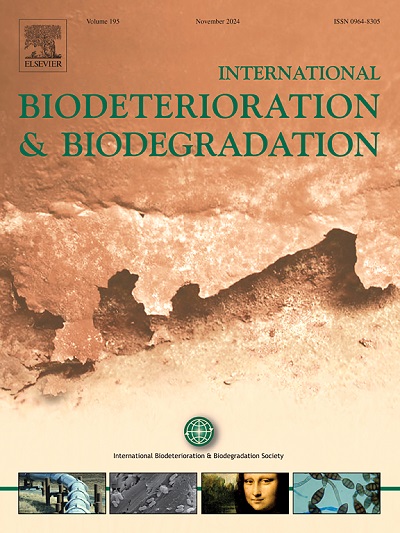在严重腐蚀硫酸盐还原生物膜中检测保守的多血红素细胞色素基因簇
IF 4.1
2区 环境科学与生态学
Q2 BIOTECHNOLOGY & APPLIED MICROBIOLOGY
International Biodeterioration & Biodegradation
Pub Date : 2025-07-15
DOI:10.1016/j.ibiod.2025.106154
引用次数: 0
摘要
硫酸盐还原菌(SRB)通常被认为是微生物影响腐蚀(MIC)的罪魁祸首,在石油和天然气管道等工程缺氧环境中可能非常丰富。海洋岩石营养SRB嗜铁Desulfovibrio菌株IS5越来越被视为厌氧钢降解的模式生物,因为它在实验室测试中具有无可比拟的严重腐蚀能力,在实验室测试中,Fe0是唯一的电子供体。最近的研究表明,多血红素c型细胞色素可能参与了该菌株对Fe0的氧化。我们在硫酸盐还原条件下的生物反应器中模拟了油田MIC,观察到材料的降解率从微不足道(0.01 mm Fe0 yr - 1)到严重腐蚀(2.75 mm Fe0 yr - 1)不等。对严重腐蚀混合微生物群落的DNA散弹枪测序显示,Desulfovibrionaceae和Desulfobulbaceae家族的宏基因组组装基因组包含与菌株IS5相似的多血红素细胞色素基因簇。这促使了引物和探针的发展,用于定量在MIC中具有关键功能的保守簇中的c型细胞色素。所谓的micC基因确实在所有腐蚀性培养物中都可以检测到,但在混合SRB群落中却没有检测到,这未能影响钢的完整性。我们通过调查不同地理位置的石油和天然气基础设施,进一步证明了新型qPCR检测的实用性。这里,micC仅在那些有micC历史的资产中检测到。系统地量化岩石营养微生物对钢铁腐蚀的遗传决定因素可以改变微生物监测策略,允许在工业应用中主动识别关键的MIC事件。本文章由计算机程序翻译,如有差异,请以英文原文为准。
Detection of a conserved multi-heme cytochrome gene cluster in severely corrosive sulfate-reducing biofilms
Sulfate-reducing bacteria (SRB), often considered primary culprits of microbially influenced corrosion (MIC), can be highly abundant in engineered anoxic environments such as oil and gas pipelines. The marine lithotrophic SRB Desulfovibrio ferrophilus strain IS5 is increasingly viewed as a model organism for anaerobic steel degradation due to its unrivalled ability to cause severe corrosion in laboratory tests where Fe0 provides the only electron donor. Recent studies suggest that multi-heme c-type cytochromes may be involved in the oxidation of Fe0 by this strain. We simulated oilfield MIC in bioreactors under sulfate-reducing conditions and observed material degradation rates ranging from negligible (0.01 mm Fe0 yr−1) to severe corrosion (2.75 mm Fe0 yr−1). DNA shotgun sequencing of severely corrosive mixed microbial communities revealed metagenome-assembled genomes of the Desulfovibrionaceae and Desulfobulbaceae families that contained a similar multi-heme cytochrome gene cluster like strain IS5. This prompted the development of primers and probes for the quantification of a c-type cytochrome in the conserved cluster with a proposed key function in MIC. The so-called micC gene was indeed detectable in all corrosive cultures yet absent in mixed SRB communities that failed to affect steel integrity. We further demonstrated the practical utility of the novel qPCR assay by surveying oil and gas infrastructure across different geographic locations. Here, micC was only detected in those assets with a history of MIC. The systematic quantification of genetic determinants underlying steel corrosion by lithotrophic microorganisms could transform microbial monitoring strategies, allowing for the proactive identification of critical MIC events in industrial applications.
求助全文
通过发布文献求助,成功后即可免费获取论文全文。
去求助
来源期刊
CiteScore
9.60
自引率
10.40%
发文量
107
审稿时长
21 days
期刊介绍:
International Biodeterioration and Biodegradation publishes original research papers and reviews on the biological causes of deterioration or degradation.

 求助内容:
求助内容: 应助结果提醒方式:
应助结果提醒方式:


